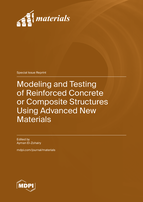Modeling and Testing of Reinforced Concrete or Composite Structures Using Advanced New Materials
A special issue of Materials (ISSN 1996-1944). This special issue belongs to the section "Construction and Building Materials".
Deadline for manuscript submissions: closed (20 March 2023) | Viewed by 38729
Special Issue Editor
Interests: innovative materials for concrete structures; green building; recycled concrete; rehabilitation of buildings and bridges; reinforced concrete structures; composite structures; finite element analysis; structural analysis; composite materials; material characterization
Special Issue Information
Dear Colleagues,
It is possible to improve the inherent brittleness and crack control ability of normal concrete by incorporating new materials. Fiber, rubber, and cementitious materials are recognized as high-performance construction materials because of their high toughness levels under compressive and tensile loads as well as the cost effectiveness. Therefore, incorporating these new materials in reinforced concrete or composite structures will affect the structural performance of these structures.
This Special Issue focuses on the emerging concepts that allow the design of reinforced concrete and composite structures including new or improved concrete material, as well as on the characterization of the properties of typical reinforced concrete and composite structures.
Authoritative review articles and original research papers describing recent findings in the field of reinforced concrete and composite structures using advanced new materials are expected to cover a range of topics.
Potential topics include, but are not limited to:
- Design of Reinforced Concrete Structures using Advanced New Materials;
- Steel-concrete composite beams incorporating new materials for concrete slabs;
- High-performance fiber-reinforced concrete composites;
- Multifunctional fiber-reinforced concrete composites;
- Ultra-high-performance fiber-reinforced concretes;
- Cementitious materials in reinforced concrete structures;
- Green concrete in reinforced concrete or composite structures;
- Structural performance of rubberized reinforced concrete structures;
- Structural application of advanced fiber-reinforced concrete composites;
- Experimental and Finite Element investigations of typical reinforced concrete or composite structures.
I hope that new ideas will promote the fast development of the exciting area of reinforced concrete and composite structures incorporating new materials. I invite you to contribute to this Special Issue by submitting papers on your best research activities.
Dr. Ayman El-Zohairy
Guest Editor
Manuscript Submission Information
Manuscripts should be submitted online at www.mdpi.com by registering and logging in to this website. Once you are registered, click here to go to the submission form. Manuscripts can be submitted until the deadline. All submissions that pass pre-check are peer-reviewed. Accepted papers will be published continuously in the journal (as soon as accepted) and will be listed together on the special issue website. Research articles, review articles as well as short communications are invited. For planned papers, a title and short abstract (about 100 words) can be sent to the Editorial Office for announcement on this website.
Submitted manuscripts should not have been published previously, nor be under consideration for publication elsewhere (except conference proceedings papers). All manuscripts are thoroughly refereed through a single-blind peer-review process. A guide for authors and other relevant information for submission of manuscripts is available on the Instructions for Authors page. Materials is an international peer-reviewed open access semimonthly journal published by MDPI.
Please visit the Instructions for Authors page before submitting a manuscript. The Article Processing Charge (APC) for publication in this open access journal is 2600 CHF (Swiss Francs). Submitted papers should be well formatted and use good English. Authors may use MDPI's English editing service prior to publication or during author revisions.
Keywords
- Fiber-reinforced concrete composites
- Rubberized concrete
- Composite Structures
- Reinforced-concrete structures
- Finite Element analysis
- Experimental investigations
- Cementitious materials
- (ULTRA) High-Performance Concrete
- Novel concrete materials
- Fiber-reinforced concrete
- Recycled concrete







